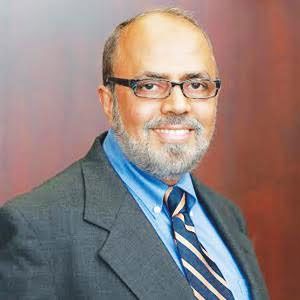 Rafi Khan, CIO, Consultant, Riverside Community Care
Rafi Khan, CIO, Consultant, Riverside Community CareIBM introduced the first desktop PC in 1981—the same year as Sage’s inception in Newcastle, UK, developing an estimating and accounting software for small businesses. Sage has since grown to almost a 2 billion USD worldwide organization. Sage’s group CEO, Stephen Kelly took the helm in November 2014 and the company’s technology strategy is finally in the right trajectory. Until Kelly, Sage is one of the last accounting software firms to offer cloud-centric solutions. This strategic delay by its previous leadership has had consequences—market-share loss to competitors such as Microsoft Dynamics GP, Intuit, Saasu, Xero, Netsuite, and other AAMEA (Australia, Asia, Middle East and Africa) and European players—all of whom offered faster implementation via online accounting cloud alternatives early in the game.
"Technology innovation and adoption is slow in legacy based organizations, so it is critical that executive buy-in be very visible"
Course Correction
Kelly has helped Sage correct its technology course and recover lost ground by ending its legacy decentralized product model focus, now scaling towards a customer engaging global online software-as-a-service (SaaS) model. Sage’s market strategy now focuses on core cloud-based solutions covering accounting, CRM, BI, ERP, Payroll, HR, and retail POS solutions—such as Sage One, Sage Life, and Sage X3.
Pegging Sage
Sage Summit 2016, its largest annual event attracting entrepreneurs, customers, and partners showcased its next generation of business technology—including its beta-version chat bot Pegg (think Siri or Google Now for accounting)—that digitizes information, acts as a personal trainer and voice based assistant for its customers’ businesses. Kelly declaring Sage as a tech company has its roots—its successful turnaround in cloud strategies has repositioned it as a market leader.
Customer Expectations
Sage’s ability to remain dominant in its global reach and market share remains to be seen. To its advantage, this is a fast-growing segment and accounting software adoption usually sticks for a longer time with a customer. If competition’s pricing delta is neutral, it still costs customer resources of time and business disruption during implementation. So even if Sage may have better product offerings, integrating it into customers’ processes and business in not the proverbial flick-of-a-switch. Security has recently been an issue–in August 2016, Sage was hit with an insider data breach, which compromised data of 280 business customers in the UK.
Engaging Customers
As with any SaaS firms, Sage’s new business model depends solely on annual or monthly subscriptions. If Sage’s products do not meet customer expectations, it is easier to be replaced compared to on premise hardware and software, since it is now all cloud based. My experiences with Sage Non-profit Solutions (sold and rebranded as Abila in 2013) was very satisfactory, especially with its prompt customer support, even during tax filing season. One can assume that Sage’s current global customer retention strategy will continue this level of support, actively engaging with and keeping its user community satisfied.
Assess, Innovate, and Execute
Selecting any software requires diligent review and shortlisting of top application players in your industry. Finance and accounting software must obviously include your finance team’s involvement—this will include folks managing G/L, payroll, billing and other touch points the company’s senior leadership determines. It will also require some level of deliberate business process review resulting in change management and business process improvement by all stakeholders. Technology innovation and adoption is slow in legacy based organizations, so it is critical that executive buy-in be very visible. Smart technology accounting application implementation is a serious project, and even more so if it is replacing a legacy system. Successful execution is dependent on legacy data migration, concurrent system maintenance, and adherence on timelines—such as when to pull the plug on the retired accounting system.
Business Process Improvement
2016 has seen significant progress for Sage. It has successfully sidestepped its own stodgy legacy, and now provides the smart technology its customers need, supporting their requirements from start-up, through to enterprise global expansion. Its partnerships with industry leaders such as Salesforce, Microsoft, Deloitte, PWC, Google, Constant Contact, Neat and even Costco complements a CIO’s decision to adopt Sage as a key player in his/her organization’s finance and accounting software selection. Challenges are usually rooted in the inadequate understanding of one’s business process, as well as the lack of an annual business process review to accommodate business dynamics and market change. The success of an accounting software adoption will depend on how you, as CIO, lead this process.
Sage Summits
Attend local technology vendor events as well as future Sage Summits. Sage works closely with partners who provide customization services on Sage’s G/L, Chart of Accounts creation and other requisite accounting software implementations. Form close business relationships with such Sage partners.
Implementation Tips
Accounting software implementation may occur around three times in a CIO’s 30-year career span. It’s a software that, once adopted, usually sticks till its end of life (EOL). So capture all finance, billing and accounting touch points. Select the top five or so Sage competitors, and once Sage is the preferred vendor selected by your CFO, work with Sage implementation partners and consultants, who will become your go-to advisors during the project rollout. Also, ensure the details are in place—Sage on the cloud will require adequate bandwidth for all your sites. Prepare for staff training. In addition, if a legacy system exists, plan data migration and concurrent maintenance through an agreed upon timeline. Then pull the old legacy system plug.